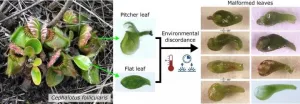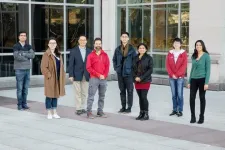When simpler is harder
A study shows that brain activity during speaking varies between simple and complex grammatical forms
2021-01-27
(Press-News.org) Speaking is something that comes across as an effortless process, almost working by itself. Our brain, however, has a lot of work to do when we construct a sentence. "In addition, languages differ in myriad ways and this also means that there are differences in how we plan what we want to say in different languages," says Balthasar Bickel, senior author of the study and a professor at the University of Zurich.
And if some languages seem easier, it is because they make fewer distinctions in their grammar. While English always uses the (e.g., in "The tree is tall" and "Snow covers the tree"), German makes a distinction between der (subject) and den (object) (e.g., in "Der Baum ist groß" and "Schnee bedeckt den Baum").
Analysing the brain just before speech
In order to do this, researchers at the University of Zurich, in collaboration with international colleagues, measured the brain activity of Hindi speakers while they described different images. This is the first time that the brain processes during the planning of sentences before speaking have been studied with high temporal resolution. "Until now, similar methods have only been used for planning single words, but not for complete sentences," explains Sebastian Sauppe, lead author of the study.
An ending with many possibilities
Researchers have discovered that although a language may seem "easier" to us at first glance, it actually requires more work from our neurons. They found that having fewer grammatical distinctions makes planning particularly demanding for the brain and requires more neural activity. The likely reason for this is that having fewer distinctions means keeping more choices open for speakers for how to continue a sentence.
"This has, however, a crucial advantage for speakers: languages with fewer distinctions allow speakers to commit to the whole sentence only late in the planning process", adds Sebastian Sauppe. This finding contributes to explaining why languages with fewer distinctions in their grammar are found more often among the world's languages, which had been shown by an earlier study of the same research group.
The research is part of the NCCR Evolving Language, a new national research centre which has set itself the goal of unraveling the biological underpinnings of language, its evolutionary past and the challenges imposed by novel technologies.
INFORMATION:
ELSE PRESS RELEASES FROM THIS DATE:
2021-01-27
A fifth basic flavour has crept into our conceptualisation of foods in recent years--umami. In Japanese, umami translates roughly to 'savoury deliciousness'.
It is often associated with the earthy flavours of meat, mushrooms, broths and vine-ripened tomatoes. It enhances saltiness and sweetness, while reducing bitterness, which is why most people love it.
But does umami exist in beverages? And if so, which fermented beverage has the most umami potential: wine, beer, sake or champagne? And, what happens to flavours when these beverages are paired with foods?
Three researchers from the University of Copenhagen's ...
2021-01-27
Researchers from the Hong Kong University of Science and Technology (HKSUST) and the University of Hong Kong (HKU) recently demonstrated that the selectivity determinant of Origin Recognition Complex (ORC) for DNA binding lies in a 19-amino acid insertion helix in the Orc4 subunit, which is present in yeast but absent in human. Removal of this motif from Orc4 transforms the yeast ORC, which selects origins based on base-specific binding at defined locations, into one whose selectivity is dictated by chromatin landscape (genomic nucleosome profile), a characteristic feature shared by human ORC.
Further understanding of the preferred DNA shapes and nucleosome positioning requirements will provide new insights for the plasticity of the human ORC in selecting replication ...
2021-01-27
Plants and other organisms can adapt their phenotypes to fluctuating environmental conditions within certain limits. The leaves of the dandelion, for example, are much more small in sunny locations than in shady places. In the sun, less leaf area is adequate to drive sufficient photosynthesis. This makes sense and is part of the dandelion's genetic programming.
However, plants can deviate from their normal programming if they are under constant heat stress or other extreme factors that endanger their survival. They then develop, for example, a wide range of leaf shapes that are extremely rare under natural conditions. In this case, scientists ...
2021-01-27
Contracting COVID-19 while pregnant can have deadly consequences for the mother, a new study published today in END ...
2021-01-27
Diabetics living in the UK worry about disruption to insulin supplies as a result of Brexit, new research shows.
Insulin is the hormone that helps control the body's blood sugar level and is critical to the survival of many people living with Type 1 diabetes. Currently most insulin used in the UK is imported.
The research - by the University of York - analysed 4,000 social media posts from the UK and the States in order to explore the experiences of living as an insulin-dependent person. Around 25 per cent of the posts relating to health were made by diabetics and about ...
2021-01-27
Rapid, sensitive diagnosis of COVID-19 is essential for early treatment, contact tracing and reducing viral spread. However, some people infected with SARS-CoV-2 receive false-negative test results, which might put their and others' health at risk. Now, researchers reporting in ACS' Nano Letters have developed ultra-absorptive nanofiber swabs that could reduce the number of false-negative tests by improving sample collection and test sensitivity.
Currently, the most sensitive test for COVID-19 involves using a long swab to collect a specimen from deep inside a patient's nose, and then using a method called reverse transcriptase-polymerase chain reaction (RT-PCR) to detect SARS-CoV-2 RNA. But if the viral load is low, which can occur early in the course of infection, the swab ...
2021-01-27
Widespread use of antibiotics in human healthcare and livestock husbandry has led to trace amounts of the drugs ending up in food products. Long-term consumption could cause health problems, but it's been difficult to analyze more than a few antibiotics at a time because they have different chemical properties. Now, researchers reporting in ACS' Journal of Agricultural and Food Chemistry have developed a method to simultaneously measure 77 antibiotics in a variety of foods.
Antibiotics can be present at trace amounts in meat, eggs and milk if the animals aren't withdrawn from the drugs for a sufficient period of time before the products are collected. Also, ...
2021-01-27
DALLAS, Jan. 27, 2021 -- Stroke survivors who completed a cardiac rehabilitation program focused on aerobic exercise, currently not prescribed to stroke survivors, significantly improved their ability to transition from sitting to standing, and how far they could walk during a six-minute walking test, according to new research published today in the Journal of the American Heart Association, an open access journal of the American Heart Association.
Cardiac rehabilitation is a structured exercise program prevalent in the U.S. for people with cardiovascular disease that has been shown to increase cardiovascular endurance and improve quality of life. Despite many similar ...
2021-01-27
Tracking milk drinking in the ancient past is not straightforward. For decades, archaeologists have tried to reconstruct the practice by various indirect methods. They have looked at ancient rock art to identify scenes of animals being milked and at animal bones to reconstruct kill-off patterns that might reflect the use of animals for dairying. More recently, they even used scientific methods to detect traces of dairy fats on ancient pots. But none of these methods can say if a specific individual consumed milk.
Now archaeological scientists are increasingly ...
2021-01-27
CHAMPAIGN, Ill. -- Researchers used single-molecule imaging to compare the genome-editing tools CRISPR-Cas9 and TALEN. Their experiments revealed that TALEN is up to five times more efficient than CRISPR-Cas9 in parts of the genome, called heterochromatin, that are densely packed. Fragile X syndrome, sickle cell anemia, beta-thalassemia and other diseases are the result of genetic defects in the heterochromatin.
The researchers report their findings in the journal Nature Communications.
The study adds to the evidence that a broader selection of genome-editing tools is needed to target all parts of the genome, said Huimin Zhao, a professor of chemical and biomolecular engineering at the University of Illinois ...
LAST 30 PRESS RELEASES:
[Press-News.org] When simpler is harder
A study shows that brain activity during speaking varies between simple and complex grammatical forms



